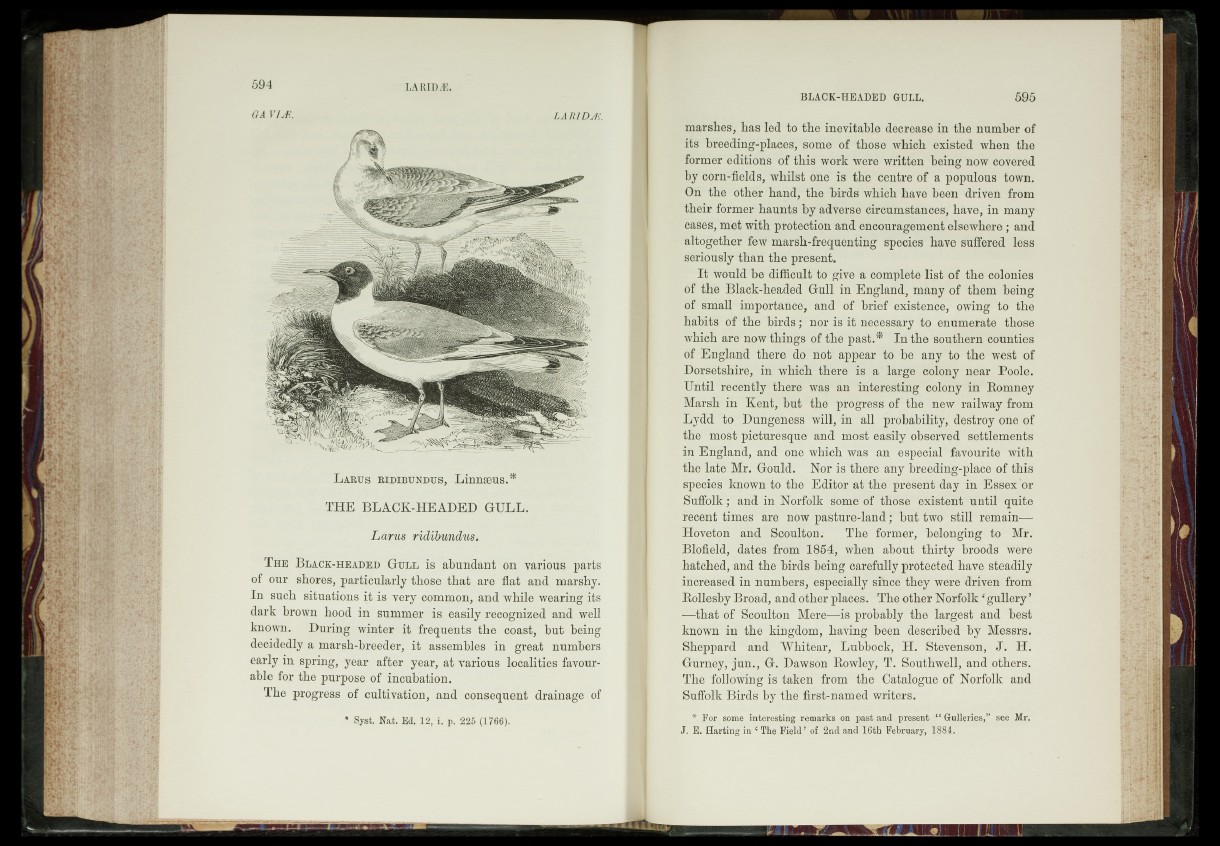
GA VJJi. LARlDuJi.
L a r us r id ib u n d u s , Linnaeus.*
THE BLACK-HEADED GULL.
Larus ridibundus.
T h e B lack-h e a d e d G u l l is abundant on various parts
of our shores, particularly those that are flat and marshy.
In such situations it is very common, and while wearing its
dark brown hood in summer is easily recognized and well
known. During winter it frequents the coast, but- being
decidedly a marsh-breeder, it assembles? in great numbers
early in spring, year after year, at various localities favourable
for the purpose of incubation.
The progress of cultivation, and consequent drainage of
* Syst. Nat. Ed. 12, i. p. 225 (1766|
marshes, has led to the inevitable decrease in the number of
its breeding-places, some of those which existed when the
former editions of this work were written being now covered
by corn-fields, whilst one is the eentre of a populous town.
On the other hand, the birds which have been driven from
their former haunts by adverse circumstances, have, in many
' cases, met with protection and encouragement elsewhere; and
altogether few marsh-frequenting species have suffered less
seriously than the present.
It would be difficult to give a complete list of the colonies
of the Black-headed Gull in England, many of them being
of small importance, and of brief existence, owing to the
habits of the birds; nor is it necessary to enumerate those
which are now things of the past.* In the southern couhties
of England there do jS t appear to be any to the west of
Dorsetshire, in which there is a large- colony near Poole.
Until recently there was an interesting colony liT'ROmney
Marsh in Kent, but fee progress of the new 'railway from
Lydd to'Dungenels will, i’k all -probability, destroy Md of
the fiolPjpIc&uresque and most easily observed settlements
in England', and one which was an espociaU favourite with
the late Mr. Gould. "Njpr is there any breeding-place of this
species known to fBe" Editor at the present day in Essex or
Suffolk; and in Norfolk somndf those existent until' quite
-rdcent times '‘are now pasture-land; but Mo"'still remain—
Hoveton and Scaulton.- The former, belonging to'" Mr.
jtthfield, dates from 1854, when about thirty broods "wkre”
hatched, and the birds being carefully protected have steadily
increased in numbers," especially s-fbce1 they were driven from
Rollesby Broad, and other places. The other Norfolk11 gullery ’
jjISthat of Scoulton Mere—is probably the largest and best
known, in the kingdom, having- Deen-desci-ibed by Messrs.
Sheppard“ and Whitear,’ Lubbock, H. Stevenson, J. H.
Gurney, jun., G. Dawson Rowley, T. Southwell, and'others-.
The following is taken from fee .-Gaik.logoe of Norfolk and
Suffolk Birds by the^Srst-named writers,
•v*-.Jlgr. some interesting remarks onnp||,and present “ Galleries,” gee Mr.
J. El Harting in ‘ The Field1 ol"^cPand 16th February, 18847